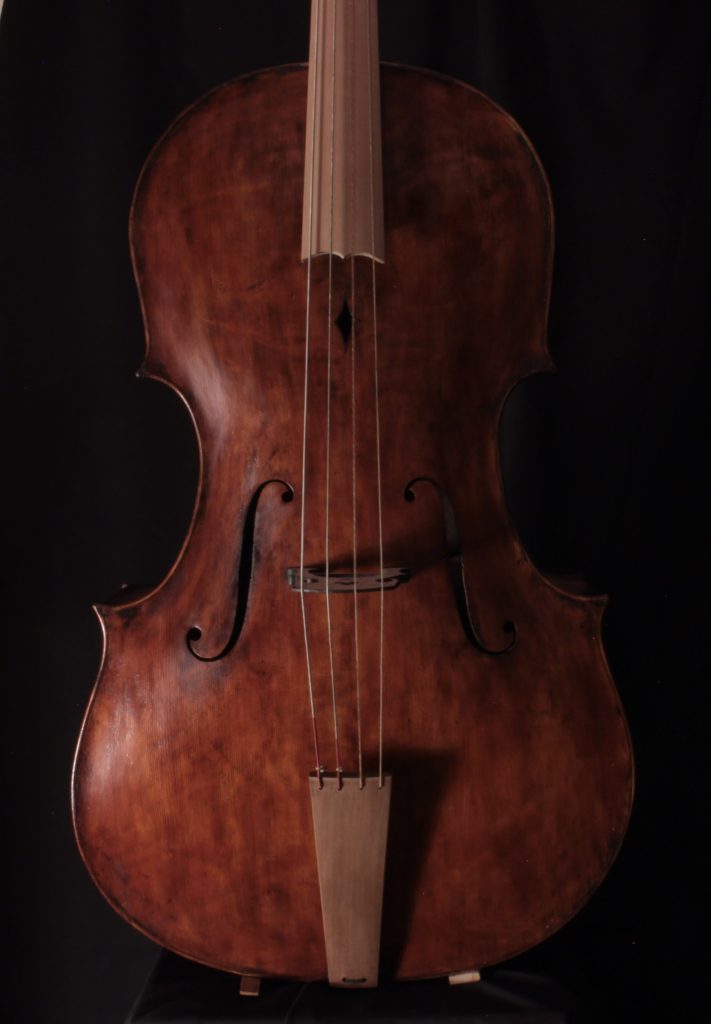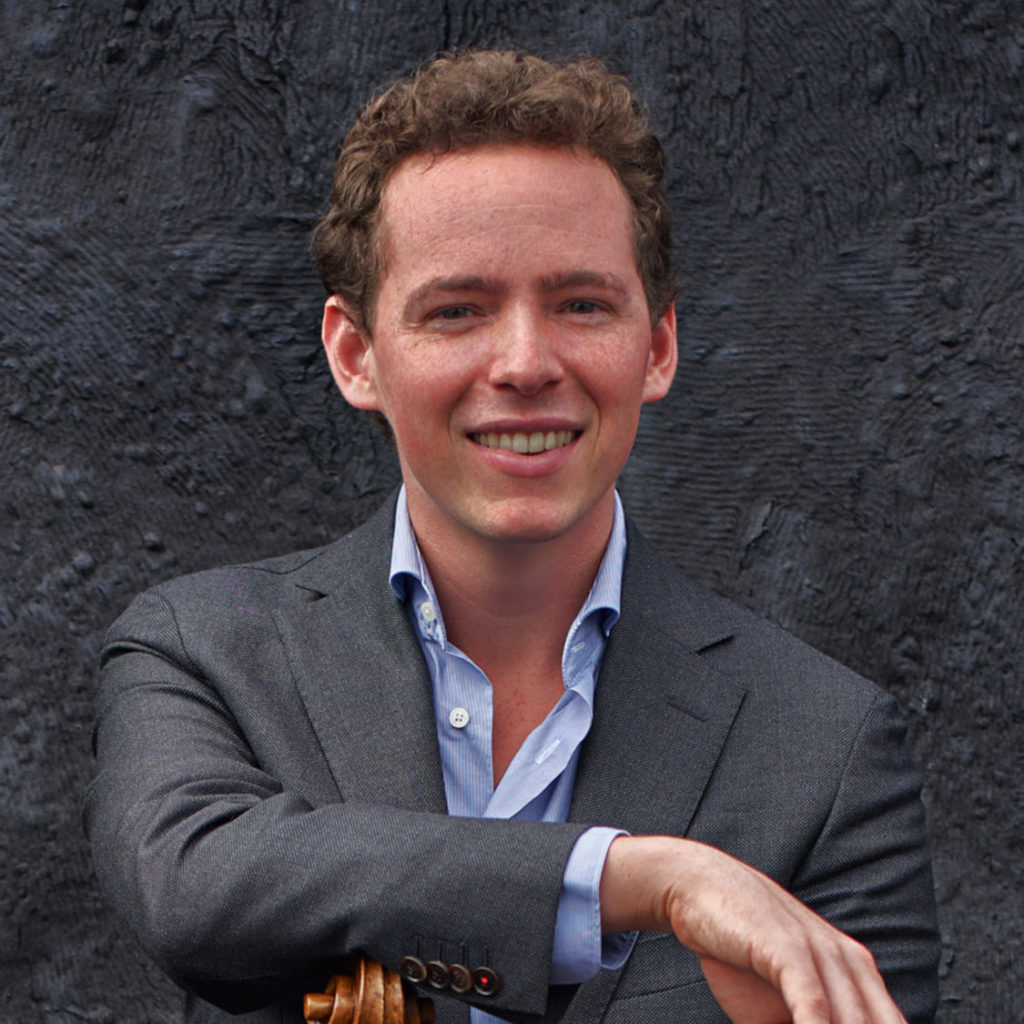
In 2006, in honour of the 25th anniversary of Jeanne Lamon’s tenure as Music Director, Tafelmusik established the Jeanne Lamon Instrument Bank (JLIB). It remains a fitting tribute to Jeanne’s deep passion for training young artists, a passion that led to the establishment of the Tafelmusik Baroque Summer and Winter Institutes. Countless emerging artists have greatly benefitted from having access to the high-quality instruments and bows that make up the collection. Thanks to very generous donations, the collection has continued to grow, and we are thrilled to premiere the newest acquisition, a basse de violon. Cellist Keiran Campbell will be playing the instrument in the Vive la différence program, and below offers a brief history and description of the basse de violon and its cousin, the violoncello.
I’m All About the Basse
By Keiran Campbell
The period spanning the 16th to 18th centuries was a time of great creativity among Italian instrument makers, as technological advances and changing musical tastes inspired new instruments to evolve. It might feel strange to think of the cello as being “new technology,” but in the early 1700s, it was exactly that. The term “violoncello” appeared for the very first time in 1665 in a collection of trio sonatas by Giulio Cesare Arresti. To put this in perspective, a hundred years earlier in the 1560s, Andrea Amati was making some of the earliest violins that exist today. The Amati workshop was not only producing violins and violas, however—they were also building large bass instruments that looked for all the world like the cello we know today, but much larger in size. Following in the footsteps of Andrea, many of the famous Italian makers who are now known for their fantastic cellos, including Antonio Stradivari, Giovanni Grancino, and David Tecchler, also made these larger bass instruments, and they almost certainly would not have called them violoncellos. They might have called them basso, or violone, or simply something that roughly translates to “bass violin,” and they would have been predominately used for bass-line playing, rather than solos. The Italian word for violin—violino—translates to “small viola,” and the word violone, which was a term used throughout the 17th century to refer to larger bass instruments, translates as “big viola.” Violoncello, then, has the wonderfully inelegant translation of “small big viola.”
So what caused the violoncello to burst onto the scene? Although there is debate among scholars, it seems fairly clear that the violoncello emerged as a tool for virtuoso players of the larger basso instruments to push their technique and expression further than ever before. Only a few years before the word “violoncello” appeared, around 1660, the silver-wound gut string was invented in Bologna. Before this invention, players of large violin-family instruments either had to use extremely thick gut strings for their lower strings, which would have been extremely awkward and slow to make speak, or they had to play large instruments with longer, but thinner strings. These large instruments with longer strings might have had a beautiful, deep sound, but players would have had to spread their fingers farther apart on the fingerboard, and shifts of the hand would have been a bit more daunting than on a smaller instrument. This would of course make rapid, virtuosic playing much more difficult.
At the end of the 17th century, makers including Stradivari began building smaller bass instruments—violoncelli—that were both powerful and agile. The cello was quickly taking up a new role as a solo instrument, and new virtuosi wanted instruments that could be easily navigated. However, it seems that the larger-bodied bass violins were still favoured for bass-line playing: although the smaller cellos had plenty of sound, the “bass violins” had a certain profundity to their low notes, which was perfect for playing a supporting role in an orchestra.
Over in France, throughout most of the baroque period, the basse de violon (“bass violin”) was the bowed bass-line instrument of choice at the French court and in the French theatres. Its size and construction, for all intents and purposes, was the same as the large bass violins over in Italy, but the depth of the basse de violon’s sound was increased by employing B- flat tuning, which simply means that the entire instrument was tuned a whole step lower than the Italian bass violin (C, G, D, A becomes B-flat, F, C, G). It should be noted that in the famous Vingt-quatre Violons du Roy, the five-part string band founded in 1626 under Louis XIII, there were no double basses—six basses de violon made up the lowest voice of the ensemble, which is a testament to the depth of their sound. Around the turn of the 18th century, solo music started to appear in France for the “violoncelle,” or “petite basse des Italiens.” As the century progressed, instrument makers all over Europe started to cut down the outdated basses so that they could be used as violoncellos, meaning that it is quite rare to find an example in original condition today.
This brings us to the wonderful new basso/basse de violon that Tafelmusik commissioned for the JLIB collection from the fantastic instrument maker Nate Tabor. When I first approached Nate about the commission, he quickly suggested making a copy of a basso by Simone Cimapane. While Cimapane is not a household name like Stradivari, he was a musician and violin maker living at the end of the 1600s in Rome. The most fascinating detail about his life, however, is that he was a musician in Corelli’s orchestra, and researchers believe that the 1692 basso was used in performances with the orchestra. That the basso has survived in original condition, and that we can trace its pedigree back to a towering giant like Corelli, is phenomenal. The instrument will make its debut on stage in Tafelmusik’s Vive la différence, and in many ways it is the perfect instrument for this program, a concert that celebrates the differences between Italian and French music, as well as the similarities that unite them. The Cimapane instrument from Corelli’s orchestra would have felt completely at home in a sea of basses de violon in an opera by Lully, and it is in this guise (and tuning) that you will hear it in the concert.
You will both see and hear the contrast between the cello I’m playing in the Corelli and Muffat works, as well as the soloistic chamber sonata by Couperin, and the new basse de violon in the three French orchestral suites. Vive la différence!
Keiran Campbell was drawn to the cello after he stumbled across one in his grandmother’s basement and was baffled by its size. Once he turned 8, he began taking lessons—on a much smaller cello—in his native Greensboro, North Carolina. After studying extensively with Leonid Zilper, former solo cellist of the Bolshoi Ballet, he received his Bachelors and Masters at the Juilliard School, working with Darrett Adkins, Timothy Eddy, and Phoebe Carrai. Keiran also spent several springs in Cornwall, England, studying with Steven Isserlis and Ralph Kirshbaum at Prussia Cove.
Keiran has performed with ensembles including The English Concert, NYBI, Philharmonia Baroque, The Boston Early Music Festival Orchestra, Four Nations Ensemble, and Les Violons du Roy. He recently performed with Le Concert Des Nations under Jordi Savall, touring Europe performing Beethoven Symphonies before recording them on Savall’s new Beethoven CD. During the summers, Keiran has performed with Teatro Nuovo, Lakes Area Music Festival, and The Carmel Bach Festival. He is also on faculty at the recently formed, UC Berkeley-based, Chamber Music Collective, which focuses primarily on post-1750 performance practice. Recent performance highlights include concerto appearances with Tafelmusik and Philharmonia Baroque Orchestra, a concert of Monteverdi Madrigals with Jordi Savall and Le Concert des Nations in Carnegie Hall, a solo recital with fortepianist Sezi Seskir at the Berkeley Early Music festival, and performances of Handel’s Saul and Solomon with English Concert at the BBC Proms and Edinburgh Festival.
Keiran is also fascinated by instrument making, which he studies with the maker of his cello, Timothy Johnson.

